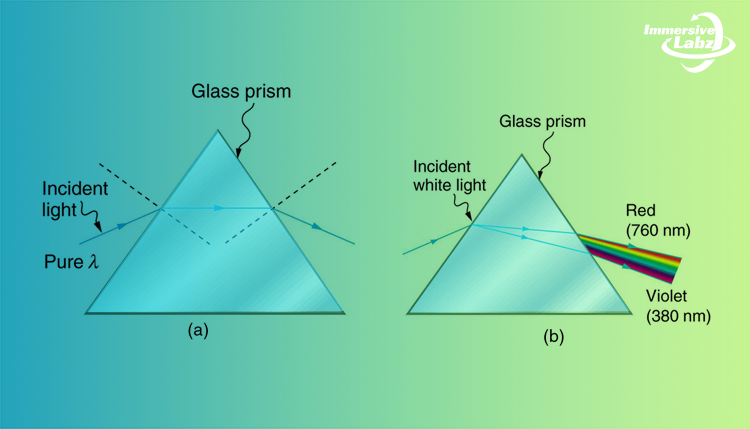Physics Practicals Class 12
Spectrometer – Prism
- Perform science experiments at your fingertips
- Learn anytime and from anywhere
- 3D gamified way of advanced learning
- Boost your academic score
- Accessible through Mobile, Laptop, Desktop, and Tablet
- Gain a competitive edge in IIT and NEET exams
About Simulation
- In this simulation, you will find a dead microscope in the lab equipment store room and get instructions to fix that problem with a microscope.
- You will understand the concept of refraction of light through a prism in this prism experiment class 12.
- You will perform the experiment to find the refractive index and the relation between the refractive index, angle of prism and angle of minimum deviation by plotting the graph.
- You will learn the relationship between the angle of incidence and the angle of deviation using a geometrical representation of ray diagrams.

- All the prism experiment steps and procedures like drawing rays on paper, measuring the angle between two rays, plotting the graph, etc., and many more are highly interactive and have been simulated in a very similar manner as you do in a physics lab.
- This interaction provides a very immersive environment and gives you a real-lab-life experience while conducting or performing experiments.
- This will help learners to better prepare for various competitive exams such as IIT-JEE (JEE Main & Advanced), NEET, and Olympiads.
Simulation Details




Description
When light travels from one medium to another medium, it is refracted and enters the new medium at a different angle. The degree of bending of the light’s path depends on the angle that the incident beam of light makes with the surface of the prism, and on the ratio between the refractive indices of the two media. This is called Snell’s law or law of refraction.
$$n=\frac{\sin i}{\sin r}$$
where, 𝑛 is the refractive index of the material of the prism.
𝑖 is the angle of incidence.
𝑟 is the angle of refraction.
Refraction Through a Prism:
A prism is an optical element. It has polished flat surfaces that refract light. The traditional geometric shape of a prism has a triangular base and two rectangular sides. It is called a triangular prism.

The angle 𝐴 between the two refracting surfaces is called the angle of the prism. In the above figure, a ray of light suffers two refractions on passing through a prism. If KL is a monochromatic light falling on the side AB, it is refracted and travels along LM. It once again suffers refraction at M and emerges out along MN. The angle through which the emergent ray deviates from the direction of the incident ray is called as the angle of deviation 𝑑.
As the angle of incidence increases, the angle of deviation decreases and reaches a minimum value. If the angle of incidence is further increased, the angle of deviation increases.
The angle of minimum deviation is obtained from the graph. Let 𝐷 be the angle of minimum deviation, then the refractive index (𝑛) of the material of the prism is calculated using the formula, $$n=\frac{\sin \left(\frac{A+D}{2}\right)}{\sin \left(\frac{A}{2}\right)}$$
Requirements for this Science Experiment
⦁ Prism ⦁ White Paper ⦁ Pencil ⦁ Protractor ⦁ Pins
Why Choose SimuLab for Science Practicals?

Image Gallery
Try SimuLab
A 3D virtual science lab (physics lab, chemistry lab, and biology lab) that helps students learn science experiments easily.















